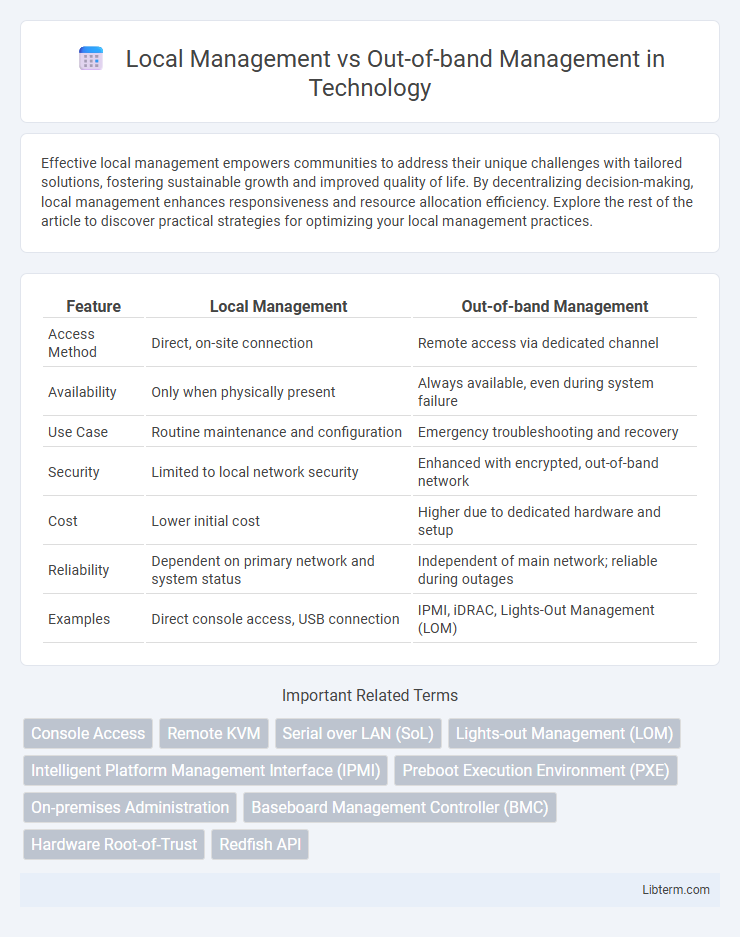Effective local management empowers communities to address their unique challenges with tailored solutions, fostering sustainable growth and improved quality of life. By decentralizing decision-making, local management enhances responsiveness and resource allocation efficiency. Explore the rest of the article to discover practical strategies for optimizing your local management practices.
Table of Comparison
| Feature | Local Management | Out-of-band Management |
|---|---|---|
| Access Method | Direct, on-site connection | Remote access via dedicated channel |
| Availability | Only when physically present | Always available, even during system failure |
| Use Case | Routine maintenance and configuration | Emergency troubleshooting and recovery |
| Security | Limited to local network security | Enhanced with encrypted, out-of-band network |
| Cost | Lower initial cost | Higher due to dedicated hardware and setup |
| Reliability | Dependent on primary network and system status | Independent of main network; reliable during outages |
| Examples | Direct console access, USB connection | IPMI, iDRAC, Lights-Out Management (LOM) |
Overview of Local Management
Local management refers to the direct control and configuration of network devices or servers using physical access, typically through a console port or integrated keyboard, video, and mouse (KVM) interface. This method enables administrators to perform maintenance or troubleshoot issues without relying on network connectivity, ensuring immediate and secure access to hardware during outages or configuration errors. Local management is crucial for initial device setup, firmware updates, and recovery scenarios where remote access is unavailable or compromised.
Introduction to Out-of-band Management
Out-of-band management (OOBM) provides a dedicated channel for network device access independent of the primary data network, enabling administrators to troubleshoot, configure, and restore systems even during network failures. Unlike local management, which requires physical presence or in-band access through the same network used for data traffic, OOBM utilizes separate management interfaces such as serial ports, cellular modems, or dedicated management networks. This approach enhances network resilience and reduces downtime by ensuring constant availability for critical maintenance and emergency interventions.
Key Differences Between Local and Out-of-band Management
Local management requires direct physical access to network devices, enabling configuration and troubleshooting only on-site, while out-of-band management leverages a dedicated management channel independent of the primary network for remote device control. Out-of-band management supports continuous network monitoring and rapid recovery even during network outages, contrasting with local management's limitation to on-site intervention. Key differences include access method, availability during network failures, and dependency on network connectivity for device administration.
Security Implications of Each Management Method
Local management confines access to network devices within the physical premises, reducing exposure to external cyber threats but increasing risks from insider attacks or physical tampering. Out-of-band management offers remote access through a separate network, enabling secure device control even when the main network fails, but requires stringent authentication and encryption to prevent unauthorized intrusion. Implementing robust access controls, multi-factor authentication, and encrypted communication channels is crucial for mitigating vulnerabilities inherent in both management methods.
Efficiency and Accessibility Comparisons
Local management offers direct device access, enhancing real-time troubleshooting efficiency without relying on network connectivity, making it ideal for immediate hardware interventions. Out-of-band management provides remote accessibility through dedicated channels independent of the primary network, ensuring efficient control during network outages or critical failures. Comparing both, local management excels in speed under physical proximity, while out-of-band management guarantees continuous accessibility and remote efficiency for geographically dispersed infrastructure.
Cost Considerations for Local vs Out-of-band Management
Local management involves direct access to hardware, requiring minimal infrastructure investment but increasing labor costs due to physical presence and manual intervention. Out-of-band management systems demand higher initial expenses for specialized hardware and software, yet reduce ongoing operational costs by enabling remote troubleshooting and minimizing downtime. Evaluating total cost of ownership reveals out-of-band management often lowers long-term expenses despite its upfront investment.
Reliability and Redundancy Factors
Local management offers direct reliability by enabling administrators to access devices through on-site interfaces, minimizing dependency on network connectivity. Out-of-band management enhances redundancy by providing an independent communication channel, ensuring remote access even during main network failures. Combining both approaches maximizes system resilience through parallel management paths and failover capabilities.
Use Cases and Deployment Scenarios
Local management suits environments requiring direct, on-site device control, such as initial setup, troubleshooting in secure data centers, or network segments with limited remote access. Out-of-band management excels in scenarios demanding remote device access during network outages or maintenance, like managing geographically dispersed infrastructure or critical servers requiring uninterrupted availability. Deployment often combines both methods: local management for routine, physical access and out-of-band for emergency recovery and remote administration.
Best Practices for Implementing Management Systems
Local management offers direct control of devices through physical or in-band network access, while out-of-band (OOB) management provides remote access via a dedicated channel independent of the primary network. Best practices for implementing management systems include establishing robust authentication protocols, segregating OOB networks to enhance security, and ensuring redundancy to maintain management access during network outages. Integrating monitoring tools for real-time alerts and regular firmware updates further optimizes operational efficiency and minimizes downtime.
Future Trends in Network Management Approaches
Future trends in network management emphasize increased adoption of out-of-band (OOB) management due to its enhanced security and reliability in addressing remote network issues without impacting primary data paths. Local management remains relevant for immediate, on-site troubleshooting but is increasingly supplemented by automated, AI-driven OOB solutions that enable proactive monitoring and faster incident response. Integration of cloud-based platforms and edge computing further accelerates the shift towards hybrid management models combining local and out-of-band capabilities for optimized network resilience.
Local Management Infographic

 libterm.com
libterm.com